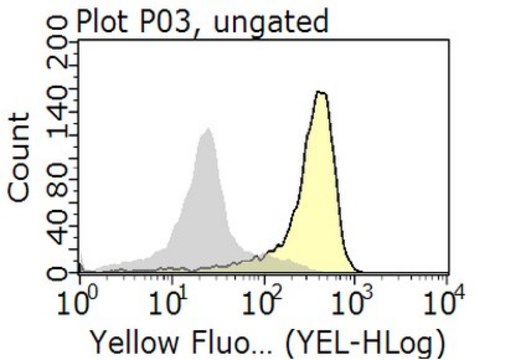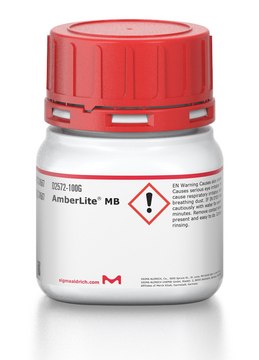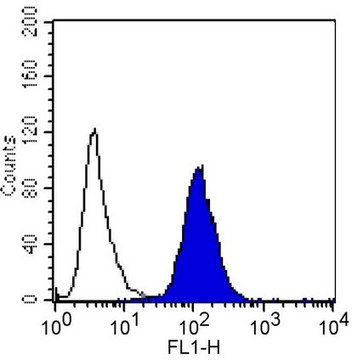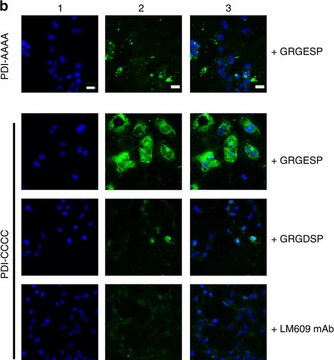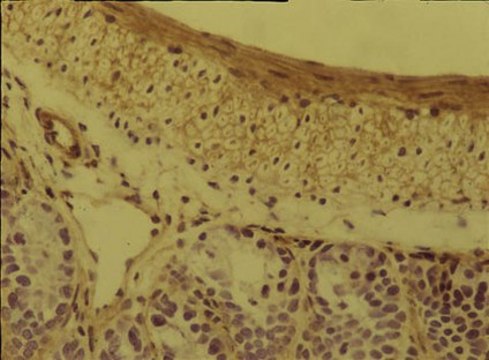MAB1969
Anti-Integrin α5β1 Antibody, clone JBS5
ascites fluid, clone JBS5, Chemicon®
Sign Into View Organizational & Contract Pricing
All Photos(1)
Synonym(s):
VLA-5
UNSPSC Code:
12352203
eCl@ss:
32160702
NACRES:
NA.41
Recommended Products
biological source
mouse
antibody form
ascites fluid
antibody product type
primary antibodies
clone
JBS5, monoclonal
species reactivity
human, monkey
manufacturer/tradename
Chemicon®
technique(s)
immunohistochemistry (formalin-fixed, paraffin-embedded sections): suitable
immunoprecipitation (IP): suitable
isotype
IgG1
NCBI accession no.
UniProt accession no.
shipped in
dry ice
target post-translational modification
unmodified
Gene Information
human ... ITGA5(3678)
General description
Integrins are a family of dimeric, transmembrane proteins that mediate cell-cell and extracellular matrix adhesion. Signals transduced by integrins play a role in many biological processes, including cell growth, differentiation, migration and apoptosis. The integrin family is composed of at least 15 alpha and 8 beta subunits that may form over twenty different alpha-beta non-covalently bound dimeric combinations on the cell surface. The alpha subunits all have some homology to each other, as do the beta subunits. Both of the subunits contribute to the binding of the ligand. Integrin alpha subunits contain seven weak sequence repeats in the N-terminal region, which may be important in ligand binding, and have been predicted to fold cooperatively into a single beta-propeller domain with seven beta-sheets. The alpha-3 subunit (CD49c) is highly concentrated in epithelial cells where it strongly adheres to Laminin-5 and Laminin-5 induced rapid adhesion can be blocked by antibodies against the alpha-3 integrin subunit. The alpha-3 subunit exists in two different splice variants, denoted as "A" and "B". The only difference that results from this differential splicing is a total change in the cytoplasmic domain, while the extracellular domain stays the same. Knock-out mice lacking this subunit show prenatal lethality and abnormalities in the kidneys.
Specificity
Reacts with the human integrin alpha5beta1.
Immunogen
Jurkat Cells
Application
Anti-Integrin α5β1 Antibody, clone JBS5 is an antibody against Integrin α5β1 for use in IH, IH(P) & IP.
Immunoprecipitation: 1-2 μg
Induction of homotypic aggregation: 100 pg/mL
Immunohistochemistry with paraformaldehyde fixation.
Paraffin embedded, PFA fixed tissue in monkey 1:50 with HIER {Qin et al., 2003}.
Inhibition of adhesion to fibronectin
Optimal dilutions must be determined by end user.
Induction of homotypic aggregation: 100 pg/mL
Immunohistochemistry with paraformaldehyde fixation.
Paraffin embedded, PFA fixed tissue in monkey 1:50 with HIER {Qin et al., 2003}.
Inhibition of adhesion to fibronectin
Optimal dilutions must be determined by end user.
Research Category
Cell Structure
Cell Structure
Research Sub Category
Integrins
Integrins
Physical form
Ascites fluid containing no preservatives.
Unpurified
Storage and Stability
Maintain for 1 year at -20°C from date of shipment. Aliquot to avoid repeated freezing and thawing. For maximum recovery of product, centrifuge the original vial after thawing and prior to removing the cap.
Analysis Note
Control
Mouse 3T3 fibroblasts Skin (Basement Membrane)
Mouse 3T3 fibroblasts Skin (Basement Membrane)
Other Notes
Concentration: Please refer to the Certificate of Analysis for the lot-specific concentration.
Legal Information
CHEMICON is a registered trademark of Merck KGaA, Darmstadt, Germany
Disclaimer
Unless otherwise stated in our catalog or other company documentation accompanying the product(s), our products are intended for research use only and are not to be used for any other purpose, which includes but is not limited to, unauthorized commercial uses, in vitro diagnostic uses, ex vivo or in vivo therapeutic uses or any type of consumption or application to humans or animals.
recommended
Product No.
Description
Pricing
WGK
WGK 1
Flash Point(F)
Not applicable
Flash Point(C)
Not applicable
Certificates of Analysis (COA)
Search for Certificates of Analysis (COA) by entering the products Lot/Batch Number. Lot and Batch Numbers can be found on a product’s label following the words ‘Lot’ or ‘Batch’.
Already Own This Product?
Find documentation for the products that you have recently purchased in the Document Library.
Nobuho Tanaka et al.
Arthritis research & therapy, 15(5), R127-R127 (2013-11-30)
Articular chondrocytes undergo an obvious phenotypic change when cultured in monolayers. During this change, or dedifferentiation, the expression of type I and type III procollagen is induced where normal chondrocytes express little type I and type III procollagen. In this
Jean-Baptiste Vincourt et al.
Cancer research, 70(11), 4739-4748 (2010-05-13)
Chondrogenic tumors that exhibit benign or malignant behaviors synthesize variable amounts of cartilage-like extracellular matrix. To define the regulators of these phenotypes, we performed a proteomic comparison of multiple human chondrogenic tumors, which revealed differential accumulation of the C-propeptides of
A biomimetic peptide fluorosurfactant polymer for endothelialization of ePTFE with limited platelet adhesion.
Larsen, CC; Kligman, F; Tang, C; Kottke-Marchant, K; Marchant, RE
Biomaterials null
Tasuku Ohno et al.
PloS one, 12(9), e0184825-e0184825 (2017-09-22)
Angiopoietin-like protein 2 (ANGPTL2) maintains tissue homeostasis by inducing inflammation and angiogenesis. It is produced in infiltrating immune cells or resident cells, such as adipocytes, vascular endothelial cells, and tumor cells. We hypothesized that ANGPTL2 might play an important role
Suzanne McFarlane et al.
Oncotarget, 6(34), 36762-36773 (2015-10-09)
CD44 expression is elevated in basal-like breast cancer (BLBC) tissue, and correlates with increased efficiency of distant metastasis in patients and experimental models. We sought to characterize mechanisms underpinning CD44-promoted adhesion of BLBC cells to vascular endothelial monolayers and extracellular
Our team of scientists has experience in all areas of research including Life Science, Material Science, Chemical Synthesis, Chromatography, Analytical and many others.
Contact Technical Service
